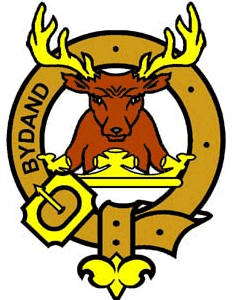Gordon Clan
Gordon Clan Crest: From a crest coronet, a stags head.
Gordon Clan Motto: Bydand (Remaining).
Gordon Clan History:
The name emerges in Scotland in late 12th century from the Parish of Gordon in Berwickshire. Richer de Gordun was lord of the Barony of Gordon in the Merse and between 1150 and 1160 granted a piece
of land and the church of St Michael to the monks at Kelso. Sir Adam de Gordon was a Warden of the Marches in 1300 and, a supporter of Robert I, was sent to Rome to petition the Pope for Bruce's excommunication
to be lifted. For his services, he was granted the lands of Strathbogie in Aberdeenshire, but died at the battle of Halidon Hill in 1333
Sir Adam's great -grandson died at the battle of Homildon in 1402 leaving his daughter Elizabeth to inherit. She married Sir Alexander Seton, second son of Sir William Seton of Seton, who took the Gordon surname. Their son was created 1st Earl of Huntly in 1436.
For the following century, the Gordons, having become embroiled in the power struggle between the House of Douglas and the House of Stewart, dominated the Highlands. James IV was a regular visitor to Huntly Castle which until 1544 was known as Strathbogie Castle. In 1496, Strathbogie Castle hosted the marriage of Perkin Warbeck, pretender to the English throne.
George, 4th Earl of Huntly was Chancellor of Scotland and had ambitions to marry his son to Mary Queen of Scots. Through a series of misunderstandings, this led to the collapse of the Gordon's power. The 4th Earl died at the Battle of Corrichie and his son was executed. The 5th Earl rebelled against James VI in 1594, which led to Huntly Castle being blown up. However, they later reconciled and in 1599, James created him Marquess of Huntly. The 2nd Marquess supported the Royalist Cause during the Civil War and, captured at Strathdon in 1647, was executed in Edinburgh two years later.
The Gordon estates and titles were restored in 1651 and in 1684, Lord Louis Gordon was raised to the Peerage at Duke of Gordon. The Gordons fought on both sides during the Jacobite Uprisings of 1715 and 1745, the 4th Duke escaping to France after the Battle of Culloden. The 5th Duke was Governor of Edinburgh Castle, but died childless which meant that the dukedom became extinct and the marquessate passed to a kinsman from whom the current Chief is descended.
John Gordon of Glenbuchat, known as 'Old Glenbucket' was a staunch Jacobite, but having taken part in the Uprisings of 1715 and 1745, was forced to flee to Norway. The Gordons of Haddo were created earls of Aberdeen in 1682 and descend from Patrick Gordon of Methlie who died at the Battle of Arbroath in 1445. The 4th Earl became British Prime Minister, 1852-55. John, 7th Earl and 1st Marquess of Aberdeen and Temair was Governor General of Canada from 1893-98, and Lord Lieutenant of Ireland, 1905-15. The poet George Gordon, 6th Lord Byron, was related to the Gordons of Gight.
General Patrick Gordon of Auchleuchries (1635-1699) educated the young Tsar Peter I in military and naval matters. He became Peter's close confidant and his chief advisor, helping him transform Russia into a major European power. The fascinating diary of General Patrick Gordon of Auchleuchries, now published in English by the Research Institute for Irish and Scottish Studies at the University of Aberdeen, provides an incomparable view of life in Russia during the reign of Peter the Great.
Robert Gordon of Auchintoul was a commander in the army of Peter the Great of Russia. His son, Alexander Gordon of Auchintoul (1669–1751) was a general in the Russian Army, but returned to Scotland to take part in the 1715 Jacobite Uprising. He wrote a biography of Peter the Great. Thomas Gordon (d.1741) was an Admiral in the Russian Navy and became Governor of Kronstadt. Charles Gordon (1833-85) was Governor of the Sudan. He was murdered on the palace steps in Khartoum.
Places of Interest:
Huntly Castle, Huntly, Aberdeenshire. Stunning ruin, featuring one of Scotland’s finest carved heraldic doorways, formerly known as Strathbogie Palace, former seat of the Gordons for over five centuries.
Aboyne Castle, Aberdeenshire. Seat of the marquises of Huntly. At the annual Aboyne Highland Gathering, the banner of the Chief of Clan Gordon is on display.
Glenbuchat Castle, Glenbuchat, Aberdeenshire. Sixteenth century Gordon tower.
Gordon Castle, Fochabers, Aberdeenshire. Seat of the dukes of Richmond & Gordon. The ancient tower of the earls of Huntly, which was known as Bog o' Gight, rises behind the present mansion.
Haddo House, Ellon, Aberdeenshire.
Seat of the marqesses of Aberdeen and Temair. Owned by the National Trust for Scotland.
The Castle of Craig, or Craig of Auchindoir, privately owned 16th century castle. This ancient seat of the Gordons of Craig was built by a grandson of Jock o' Sgurdargue.
Ruthven (Riven) kirkyard, between Huntly and Keith, effigy of the famous Gordon knight Thomas Gordon of Daugh, more commonly known as Tam o' Riven, brother of Jock o' Sgurdargue.
Surname distribution in Scotland: The highest concentrations of the Gordon name occur in Aberdeenshire (includes all of the historic counties of Aberdeenshire, Kincardineshire and part of Banffshire), Aberdeen City, Moray (including most of historic Banffshire), Highland (includes the historic counties of Caithness, Inverness-shire, Nairnshire, Ross and Cromarty and Sutherland), Perth and Kinross (Perthshire and Kinross-shire) and Dumfries and Galloway (Dumfriesshire, Kirkcudbrightshire and Wigtownshire).
Associated family names (Septs): Adam, Adams, Adamson, Addie, Addison, Adie, Aitchison, Aiken, Aitken, Atkin, Atkins, Atkinson, Barrie, Brander, Connon, Craig, Cromb, Crombie, Cullen, Darg, Dargie, Dorward, Duff, Durward, Eadie, Eddie, Edie, Edison, Esslemont, Gardiner, Gardner, Garioch, Garrick, Garriock, Geddes, Gerrie, Huntly, Jessiman, Jopp, Jupp, Laing, Lang, Laurie, Lawrie, Leng, Marr, Maver, Mavor, Meldrum, Mill, Mills, Miln, Milne, Milnes, Moir, More, Morrice, Morris, Muir, Mylne, Tod, Todd, Troup.
Gordon Clan membership certificates.

